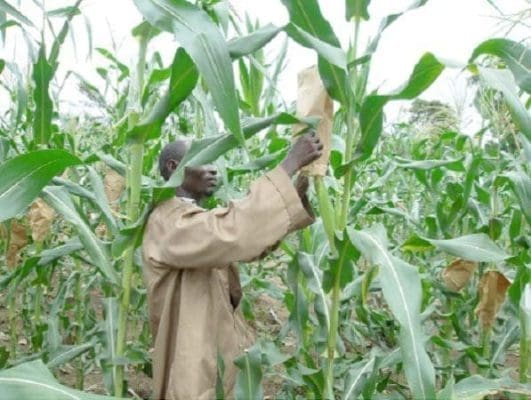
Maize farmers in the Bono Region are calling for urgent government intervention as an oversupply of grain threatens to wipe out their investments, with abandoned storage facilities and collapsing prices compounding their difficulties during the current harvesting season.
The crisis facing farmers in one of Ghana’s key agricultural zones mirrors a nationwide problem where more than 100,000 metric tonnes of maize and rice from the 2024 harvest remain unsold. The situation has left farmers trapped in debt and threatens the survival of local processors, according to recent assessments of Ghana’s agricultural sector.
Data from the United Nations Food and Agriculture Organization (FAO) indicate Ghana loses close to 30 percent of its grains to post harvest losses, though some experts suggest this figure may be overestimated. The lack of adequate storage infrastructure has become particularly acute in the Bono Region, where farmers report struggling to preserve their harvests or access ready markets.
The nationwide grain glut stems from inadequate foresight in agricultural planning rather than overfarming, according to analysis by IMANI Africa. The Chamber of Agribusiness Ghana has warned that the glut, worsened by an influx of cheap imports and rampant smuggling of substandard grains, is destabilizing the sector.
Farmers unable to store their produce or access ready markets have been forced to sell at prices below production cost, pushing them into financial distress. The lack of storage facilities, poor transportation networks and weak coordination between farmers, processors and buyers has created a chain reaction of inefficiency.
In farming communities across the Northern, Bono East and Volta Regions, traders are offering farmers prices far below production cost or not showing up at all. The situation has been complicated by smuggled maize and rice which bypass taxes and quality inspections, being dumped on Ghanaian markets at artificially low prices.
The Chamber of Agribusiness Ghana cautions that if government fails to act, entire subsectors of the rice and maize industry could collapse. Already, some mills and processing plants are operating far below capacity, while others have shut down completely due to lack of sales.
More than 1.3 million metric tonnes of paddy rice are stuck in warehouses due to lack of buyers, according to the Rice Producers Association and Apex Farmers Association. The situation has become so dire that a committee representing multiple farmer associations has threatened to boycott the 2025 Farmer’s Day celebration across all levels if the government doesn’t take immediate action.
The Minority in Parliament has demanded the Agriculture Minister’s briefing over the nationwide food glut. In response, Majority Leader Mahama Ayariga disclosed that Cabinet has approved the release of funds to the National Food Buffer Stock Company to purchase the excess produce.
Earlier this month, the National Food Buffer Stock Company (NAFCO) announced the release of GHS 100 million to purchase excess grains and set minimum guaranteed prices for maize, rice, and gari. However, more than 200,000 metric tonnes of unsold paddy rice and maize remain from the previous farming season, while several rice farms are yet to be harvested.
The Peasant Farmers Association of Ghana (PFAG) has warned that the situation exposes farmers to further losses from bird invasions, bushfires, and inadequate harvesting equipment. The association cautioned that if the crisis persists, it could discourage many farmers, particularly the youth, from participating in the next planting season, potentially undermining the government’s Feed Ghana initiative.
The storage infrastructure crisis extends beyond the Bono Region. In November 2024, the Chamber of Agribusiness Ghana urged government to reconsider plans for grain silos in non major producing areas. The Chamber’s research indicates that Kwahu and Eastern Region, where the silo is planned, is not a major grain producing area in Ghana. They advocate for investment in silos in key grain producing regions like Bono, Ahafo, Ashanti, Volta, and Upper West.
The drought that affected production in 2024 has created additional complications. Climate challenges reduced the 2024/2025 maize harvest significantly, yet the surplus from previous seasons combined with inadequate storage and market systems has created the current glut. The Bono Region adopted climate smart agriculture techniques in response to the 2024 drought that crippled food production across all 12 municipalities and districts.
IMANI Africa warns that unless government shifts its focus from production targets to market systems, Ghana will continue experiencing such wasteful gluts. The think tank recommends a stronger national framework for storage, processing and coordinated marketing, as well as tightened border management to protect local producers.
The PFAG has reiterated its call for legislation compelling state institutions including schools, hospitals, and security services to procure only locally produced rice and maize. It further recommended stricter border controls to prevent smuggling of inferior rice, a temporary ban on rice imports, and a coordinated public campaign to promote local rice consumption.
The association urged the government and stakeholders to develop a comprehensive national strategy to address marketing challenges in the agricultural sector, covering crops such as vegetables, cereals, and legumes, to prevent similar crises in the future. The analysis signals that unless production policies are complemented with post harvest planning, the outcome will always be waste.
Agricultural experts note that Ghana’s challenges with post harvest losses vary significantly depending on storage conditions and pest management. While FAO estimates suggest losses can reach 20 to 30 percent for cereals, more recent field studies indicate actual storage losses under proper conditions are often closer to five to ten percent over a storage season.
The current crisis highlights the contradiction where abundant harvests leave farmers financially distressed, exposing critical weaknesses in Ghana’s post harvest market systems. If the country wants to achieve food security and self sufficiency, it must treat post harvest management and market linkages with the same urgency as production targets.
